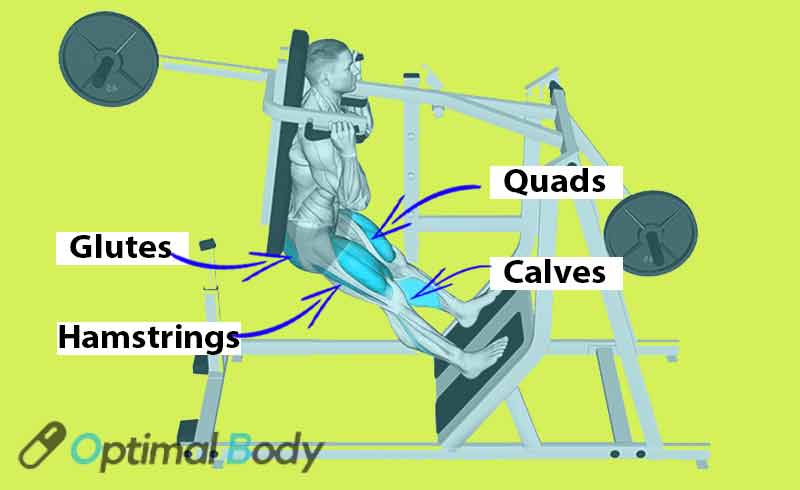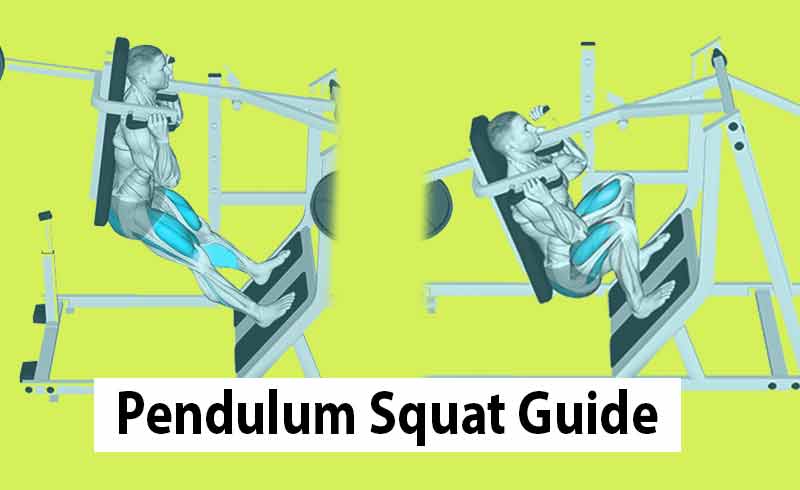The Pendulum Squat is a specialized exercise machine that may not be commonly found in every gym.
However, it offers unique benefits that make it worth exploring.
This exercise involves a lever and plates, providing a controlled range of motion for the legs.
The footplate is adjustable, allowing users to find the most suitable foot position for their biomechanics.
What is the Pendulum Squat?
The Pendulum Squat is a safe and efficient leg workout that helps you engage your quad and leg muscles.
All you need is a piece of unique equipment with a lever and an adjustable footplate. It’s a fantastic technique to tone and strengthen your legs.
The pendulum squat machine increases the torque and load on your muscles because the moment arms increase. Even though the weight stays the same, it feels way harder at the top due to these longer-moment arms.
This design helps you challenge your muscles throughout the entire range of motion, making it more efficient for building strength and muscle.
So, If your gym has a pendulum squat machine, don’t hesitate to try it out to effectively wo
rk your legs and strengthen your quadriceps while preserving your lower back.
This versatile exercise allows you to adjust resistance and foot positioning to target different parts of the legs, making it an excellent choice for a comprehensive and balanced workout.
Muscles Worked During the Pendulum Squat

The Pendulum Squat primarily targets the muscles of the lower body, with a specific focus on the quadriceps (front thigh muscles).
Additionally, other muscles in the legs and core are engaged to stabilize and support the movement.
- Quadriceps (Quads): The quadriceps muscles are the primary movers during the Pendulum Squat. They work to extend the knee joint as you push yourself up from the squatting position.
- Hamstrings: The hamstrings, located at the back of the thigh, act as synergists during the Pendulum Squat. They assist the quadriceps in extending the knee joint and stabilizing the movement.
- Gluteus Maximus (Glutes): The glutes play a supportive role during the Pendulum Squat. They help to extend the hips as you push up from the squat position.
- Calves (Gastrocnemius and Soleus): The calf muscles aid in stabilizing the ankles and providing balance during the exercise.
- Core Muscles: The core muscles, including the abdominals and lower back, play a vital role in stabilizing the spine and maintaining proper posture throughout the movement.
- Adductors and Abductors: The adductor muscles (inner thigh) and abductor muscles (outer thigh) assist in stabilizing the legs during the Pendulum Squat.
Alternative Exercise: How To Do V-Squat Properly?
How to Perform the Pendulum Squat
Before diving into the mechanics of the Pendulum Squat, let’s watch this video for a man doing pendulum squats:
How to Perform the Pendulum Squat:
- The first step is to set the footplate in a position that feels comfortable for you. Experiment with different settings to find the one that suits your biomechanics best.
- Position yourself with your back against the pad and feet on the footplate. Make sure to drive through your heels during the movement rather than your toes.
- Begin the exercise by bending your knees and lowering yourself into a squatting position. Notice the nice and beefy range of motion achieved with this machine.
- As you ascend, push off slightly to engage your leg muscles effectively.
- Repeat.
The controlled movement ensures that you’re targeting the right muscles and minimizing stress on your knees and lower back.
Exercise Tips:
- While keeping even pressure on the balls and heels of your feet, place your feet as low on the platform as you can.
- Be careful not to elevate your heels while performing the motion. Maximum knee flexion will be possible as a result, and the quadriceps will be activated more.
- You can vary the position of your feet to target different muscle groups. A wider stance targets the inner thighs, while a narrower stance focuses on the outer quadriceps.
You can also place your feet higher to target the hamstrings and glutes or lower to emphasize the quadriceps.
This variety is essential for stimulating different muscle groups in a balanced manner. - To avoid straining the lower back, descend as low as you can while keeping your back pressed against the backrest.
Pendulum Squat Benefits: Why Choose Them?
The Pendulum Squat presents several advantages over traditional free weight squats, making it a valuable addition to any leg workout routine.
The following are the key benefits:
- Enhanced Safety: Unlike free weight squats, the Pendulum Squat provides better back support, reducing the risk of injury during high-intensity sets.
- Reduced Knee and Back Pressure: The machine’s design minimizes pressure on the knees and back, making it ideal for individuals with existing knee or lower back issues.
- Optimal Muscle Targeting: The adjustable footplate and unique mechanics allow users to target their quads effectively and work through a full range of motion, promoting muscle growth and strength development.
- Individualized Biomechanics: Machines like the Pendulum Squat cater to individual biomechanics, accommodating those who struggle with barbell squats due to their unique body structure.
Other Benefits:
The Resistance Profile
Now, let’s talk about resistance profiles. In exercises like hack squats or freeweight squats, the resistance profile remains flat throughout the movement.
The weight remains constant, and the resistance feels the same. However, in the pendulum squat, the resistance profile changes because the moment arms change.
When you do a pendulum squat, the moment arm is shorter at the bottom position and longer at the top position.
This means the load on your muscles increases as you rise up. So, even though the weight stays the same, the exercise feels heavier at the top.
This unique resistance profile aligns better with your body’s capabilities and makes the pendulum squat an excellent choice for efficient training.
Ankle Mobility Advantage
Another advantage of pendulum squats is the flexibility it offers for ankle mobility. In hack squats, the angle between the back pad sled and foot platform can influence ankle mobility requirements.
If the angle is too closed, it can put strain on your ankles and knees. On the other hand, if the angle is too open, it may lead to sliding feet and reduced stability.
However, pendulum squats provide a sweet spot where the angle changes throughout the movement. As you descend, the angle becomes more closed, reducing ankle mobility requirements.
As you rise, the angle opens up, giving your femur more space to move back and relieving ankle strain. This makes pendulum squats an excellent option for those with limited ankle mobility.
Best Pendulum Squats Alternatives
1. Front Squat:
The front squat is a lower-body exercise where the barbell is placed in front of the body, resting on the shoulders and clavicle. It can be done using a barbell or a cable machine
Unlike the back squat, the front squat requires an upright torso to keep the bar from falling forward, this position emphasizes the quadriceps and reduces stress on the back.
2. Sissy Squat:
The sissy squat is a compound exercise that isolates the quadriceps.
It can be performed either with bodyweight or using a sissy squat machine.
The movement involves leaning back while allowing the knees to come forward, similar to the limbo, and then extending the legs to come back up.
3. Barbell Hack Squat:
This is a hack squat performed with a barbell behind the back. You bend down to grab the barbell and then sit back, creating a position similar to the hack squat machine.
It can be done in two ways, one where you come up on your toes, and the other where your feet remain flat on the ground.
4. V-Squats:
V-squats are performed using a special machine where the lifter stands on two angled platforms and performs squats.
This exercise targets the quadriceps and provides a similar movement pattern to the hack squat.
5. Smith Machine Squats:
Using a Smith machine, perform squats with a fixed barbell. The guided movement helps maintain stability and allows for better focus on the quadriceps.
Wrapping Up:
I recommend incorporating the Pendulum Squat into your leg workout routine after warming up with other exercises.
This approach ensures that your muscles are prepared for the intensity of the machine.
Experiment with foot positioning to find what works best for you.
Personally, I prefer driving through the heels.
References:
- Alkner BA, Tesch PA, Berg HE. Quadriceps EMG/force relationship in knee extension and leg press. Med Sci Sports Exerc. 2000 Feb;32(2):459-63. doi: 10.1097/00005768-200002000-00030. PMID: 10694132.
Kenneth Anderson and David G. Behm. 2011. Trunk Muscle Activity Increases With Unstable Squat Movements. Canadian Journal of Applied Physiology. 30(1): 33-45. https://doi.org/10.1139/h05-103
- Shah, N. (2008, May). Increasing Knee Range of Motion Using a Unique Sustained Method. National Institute of Health. Retrieved January 20, 2023, from <https://www.ncbi.nlm.nih.gov/pmc/articles/PMC2953321/>
- M. R. Rhea, “Determining the magnitude of treatment effects in strength training research through the use of the effect size,” Journal of Strength and Conditioning Research, vol. 18, no. 4, pp. 918–920, 2004.
- Bench Press Calculator - April 22, 2024
- Press to Handstand: Ultimate Step-by-Step Guide - April 22, 2024
- Cable Press (How To Do, Benefits, Targeted Muscles, Alternative) - April 22, 2024

